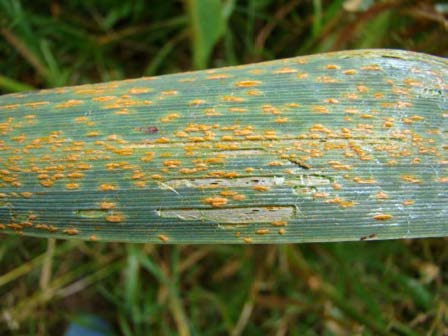
Rust
Puccinia Alli
Pathogen:
Fungus
Type:
Risk:
HIGH




DESCRIPTION
Pathogen description
Puccinia alli is a phytopathogenic fungus responsible for rust in garlic. This pathogen is characterized by its complex life cycle that involves several stages of development and different spore forms. It begins as a spore that is dispersed by the wind and deposits on the leaves of garlic. Once on the surface of the leaf, the spore germinates in the presence of adequate humidity and temperatures, penetrating the leaf tissue through the stomata. Within the tissue, the fungus forms specialized structures called haustoria, which absorb nutrients from the garlic cells. During the growing season, the fungus produces urediniospores, which are responsible for the secondary spread of the disease within the crop. As conditions change, teliospores form, which survive adverse conditions and facilitate the perpetuation of the pathogen over seasons.
Disease description
Puccinia alli rust on garlic manifests itself as a foliar disease that affects photosynthesis and overall plant vigor. The infection begins with the appearance of small chlorotic Taches on the leaves, which quickly evolve into orange or reddish pustules filled with spores. These pustules release spores that infect other parts of the plant and neighboring plants, causing rapid spread of the disease. Severe infection can lead to premature defoliation, reduced growth and lower bulb yields.
- Chlorotic Taches on the leaves.
- Orange or reddish pustules on the leaf surface.
- Deformation and weakening of the leaves.
- Premature defoliation.
- Reduction in the size and quality of the bulbs.
- General wilting of the plant.

TEMPERATURE AND HUMIDITY
10°C - 25°C
80% - 100%

VOIES DE TRANSMISSION
Wind, contaminated tools, contact with infected plants, crop residues, contaminated irrigation water

Chemical treatments
CONTROL
• FLUXAPYROXAD 7.5% + DIFENOCONAZOLE 5% [SC] P/V
• TEBUCONAZOLE 50% + TRIFLOXISTROBIN 25% [WG] P/P
• FLUOPYRAM 20% + TEBUCONAZOLE 20% [SC] P/V
• AZOXISTROBIN 25% [SC] P/V
• AZOXISTROBIN 25% [SC] P/V
Treatments authorized in organic farming
-
Biological control
-
Preventive treatments
• FLUXAPYROXAD 7.5% + DIFENOCONAZOLE 5% [SC] P/V
• TEBUCONAZOLE 50% + TRIFLOXISTROBIN 25% [WG] P/P
• FLUOPYRAM 20% + TEBUCONAZOLE 20% [SC] P/V
• AZOXISTROBIN 25% [SC] P/V
• AZOXISTROBIN 25% [SC] P/V
- Implement crop rotations with non-host plants to reduce the accumulation of the pathogen in the soil.
- Remove and destroy remains of infected crops to minimize the source of inoculum.
- Use rust-resistant varieties of garlic, if available.
- Apply preventive and curative fungicides following the specific technical recommendations for garlic cultivation.
- Improve ventilation in the field through adequate planting density to reduce humidity in the foliage.
- Avoid sprinkler irrigation, especially in the afternoon hours, to reduce prolonged foliar humidity.
- Regularly inspect crops and eliminate affected plants at the first sign of infection.
- Use integrated pest management practices that include constant monitoring and appropriate cultural measures.
- Maintain the general health of the crop through balanced fertilization and proper irrigation management.
Recommendations
*The recommended treatments are recommendations based on the authorities' databases and do not replace in any way the guidelines established by the legislation of each country.





